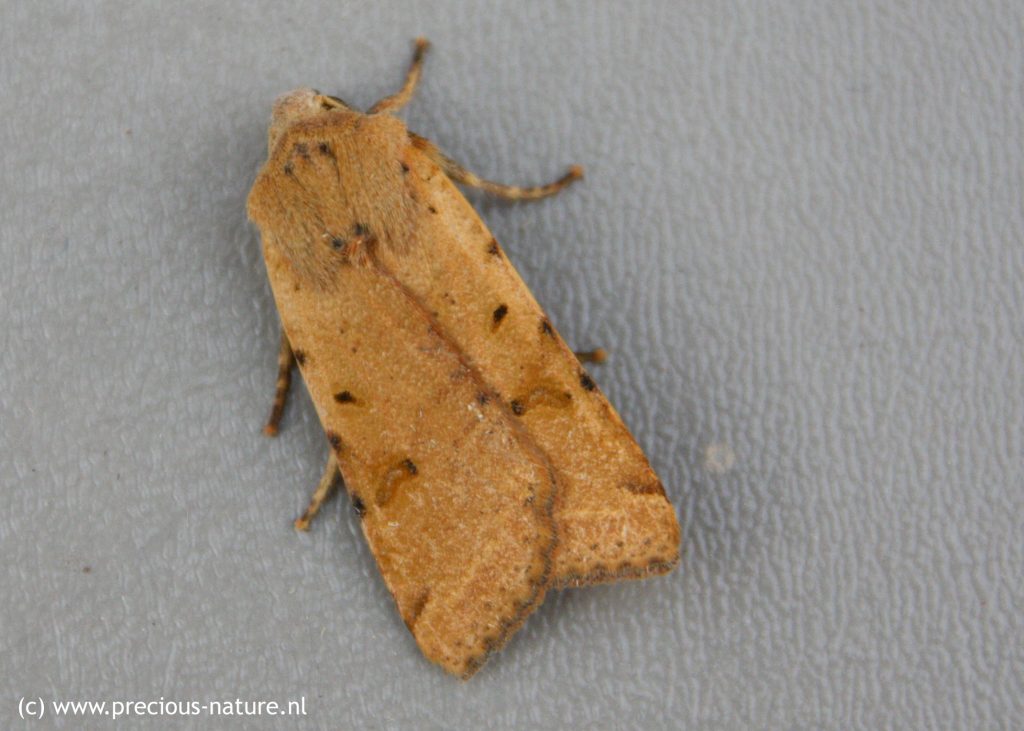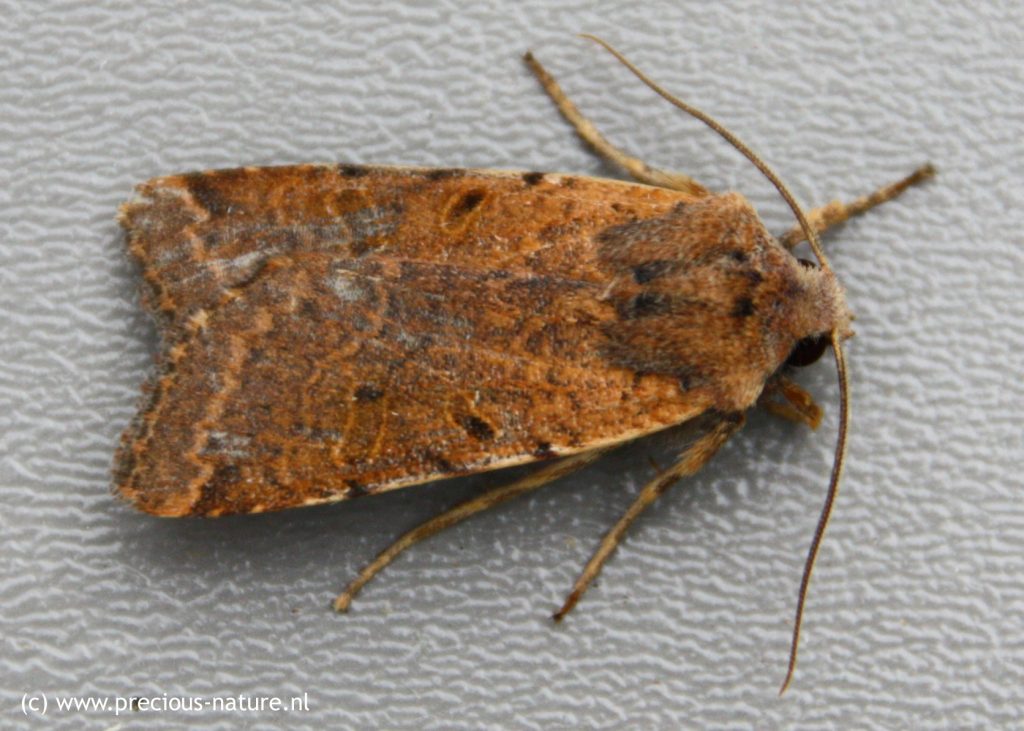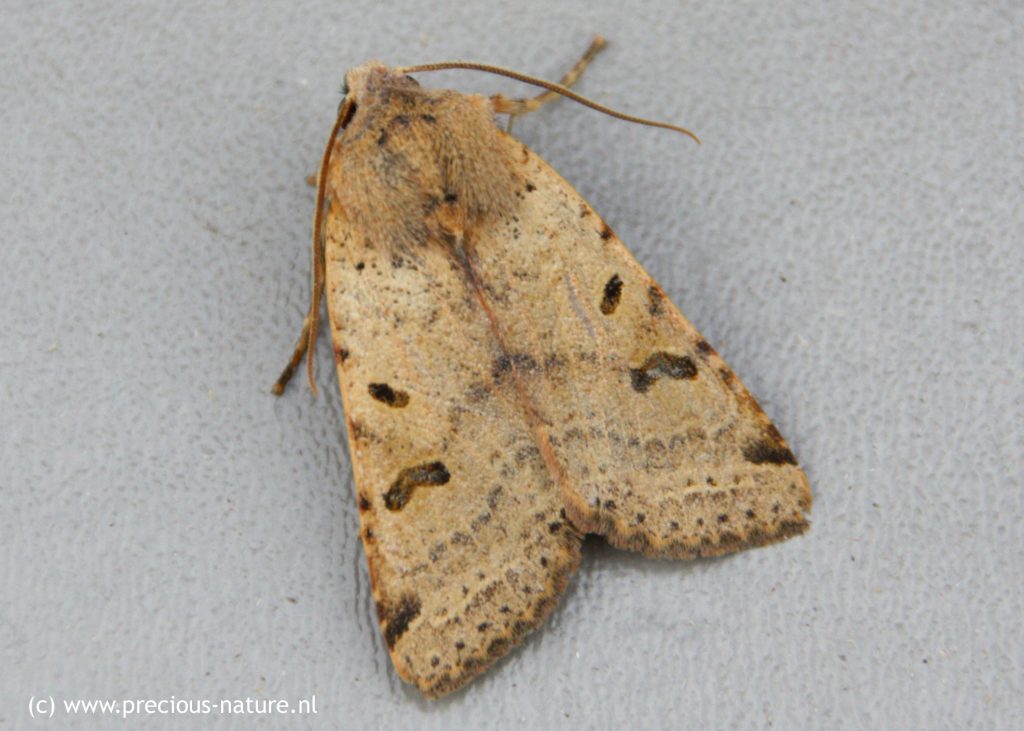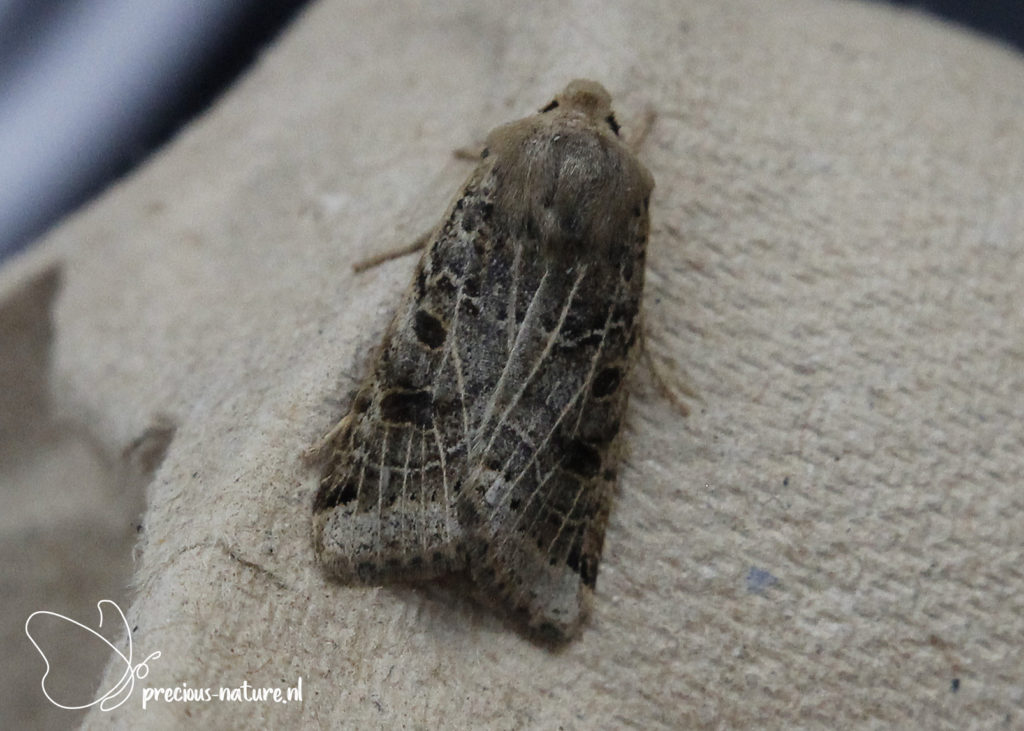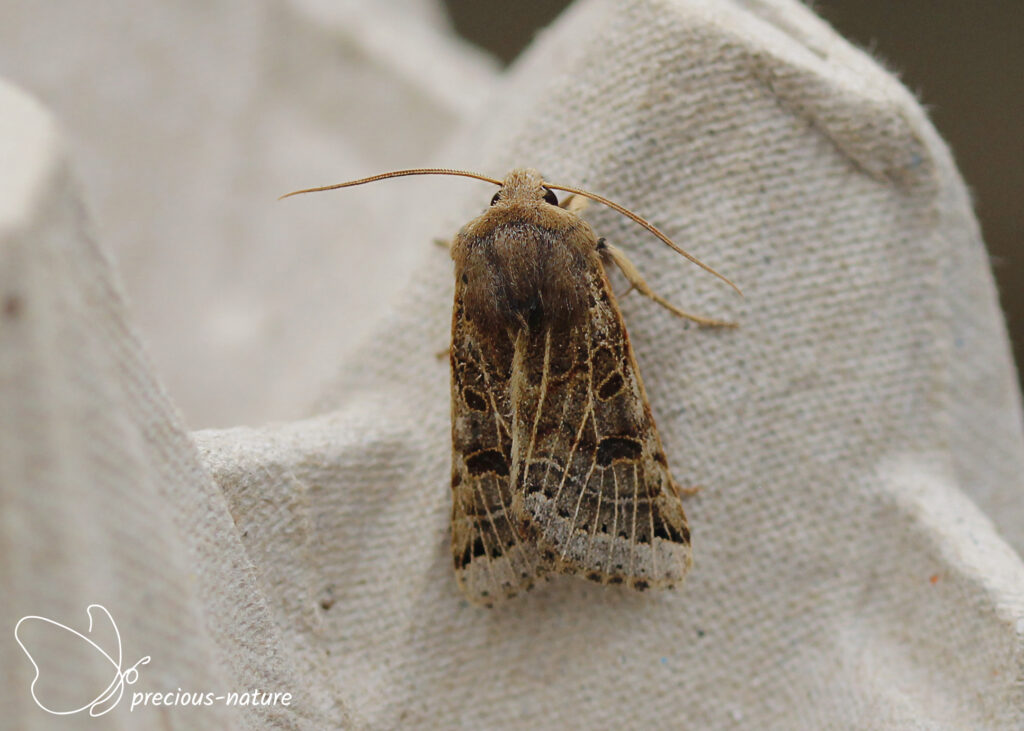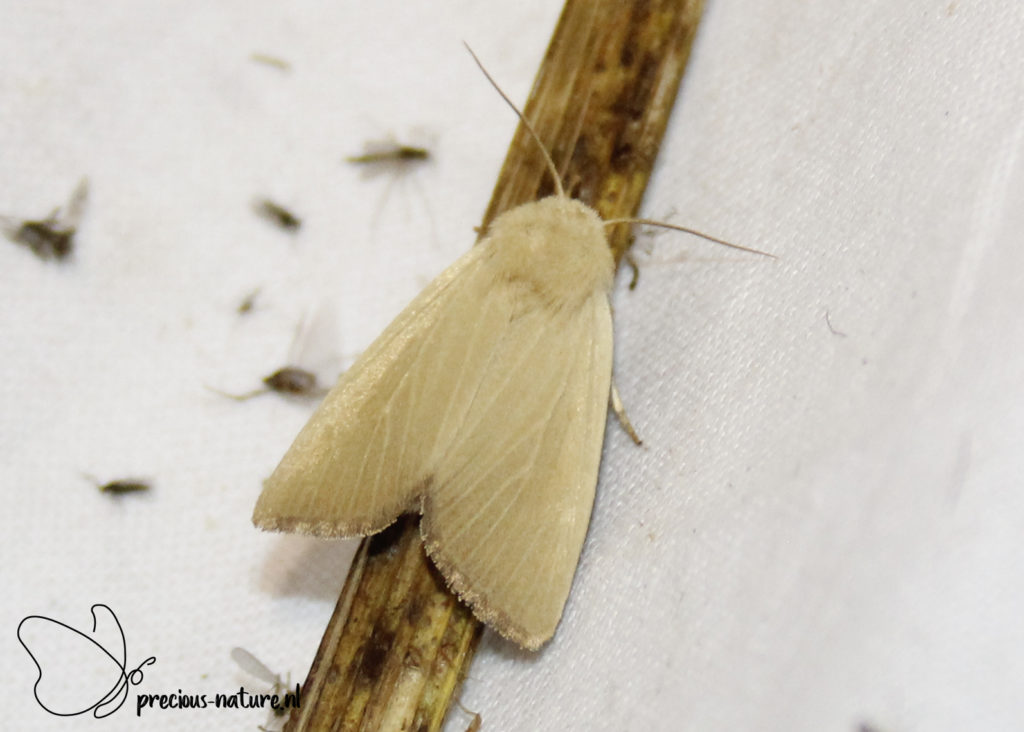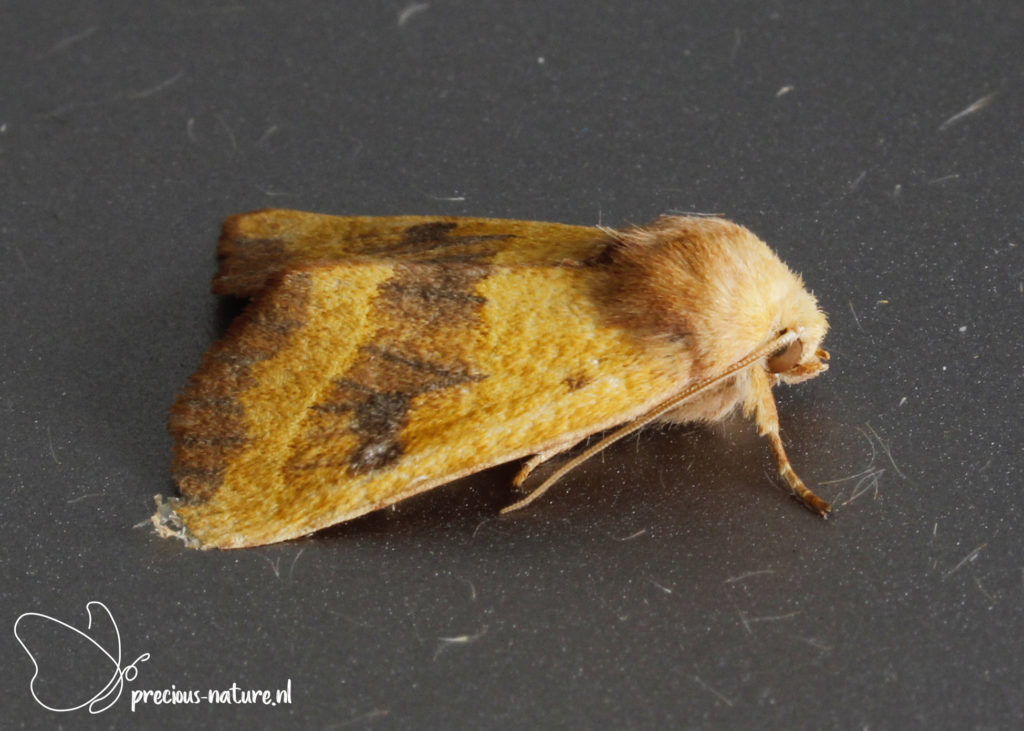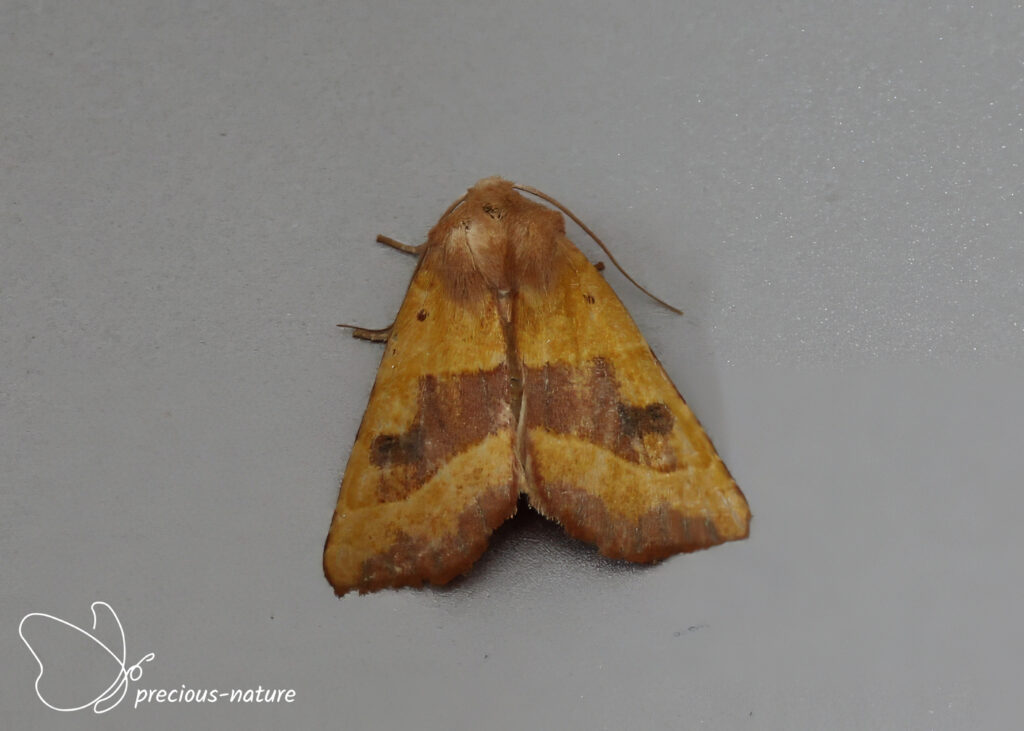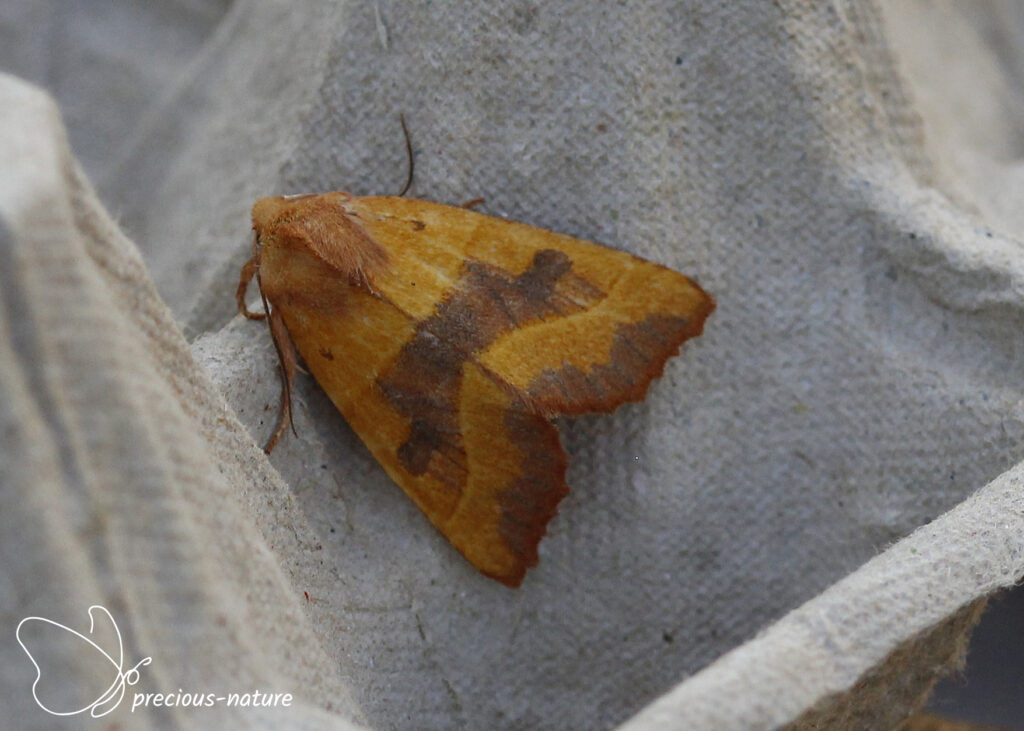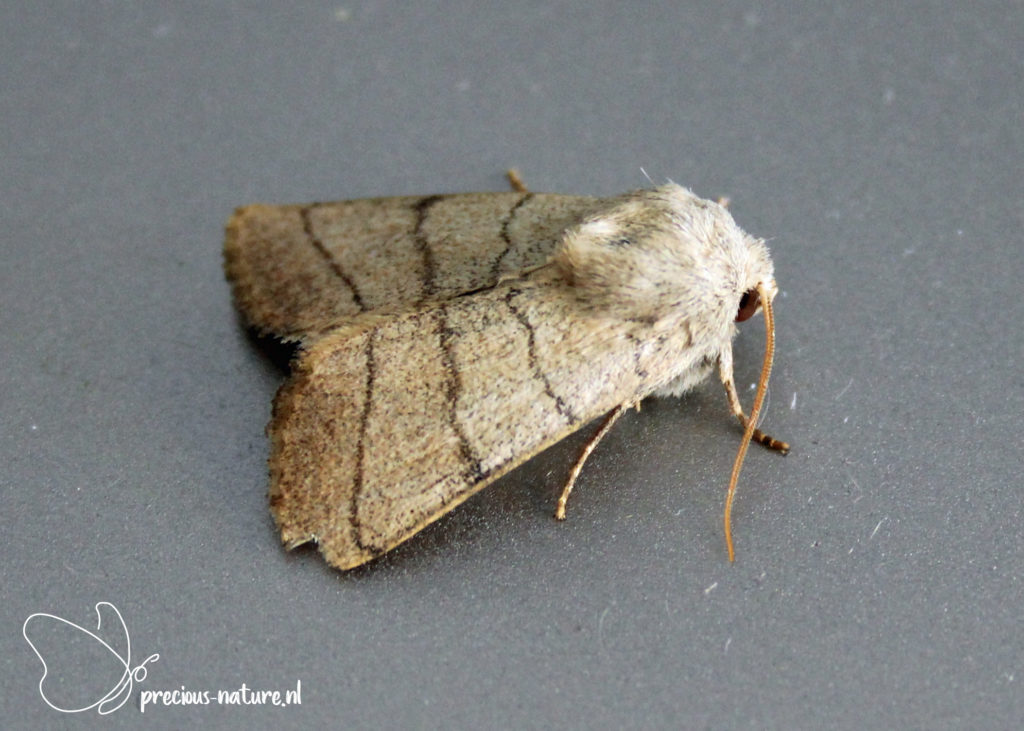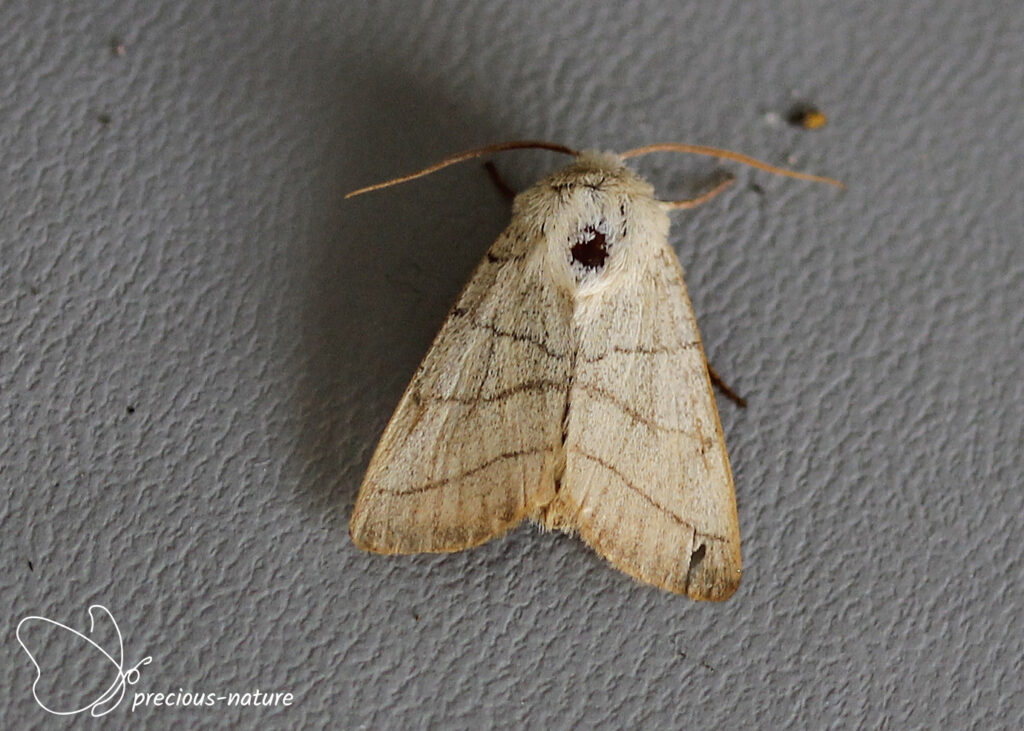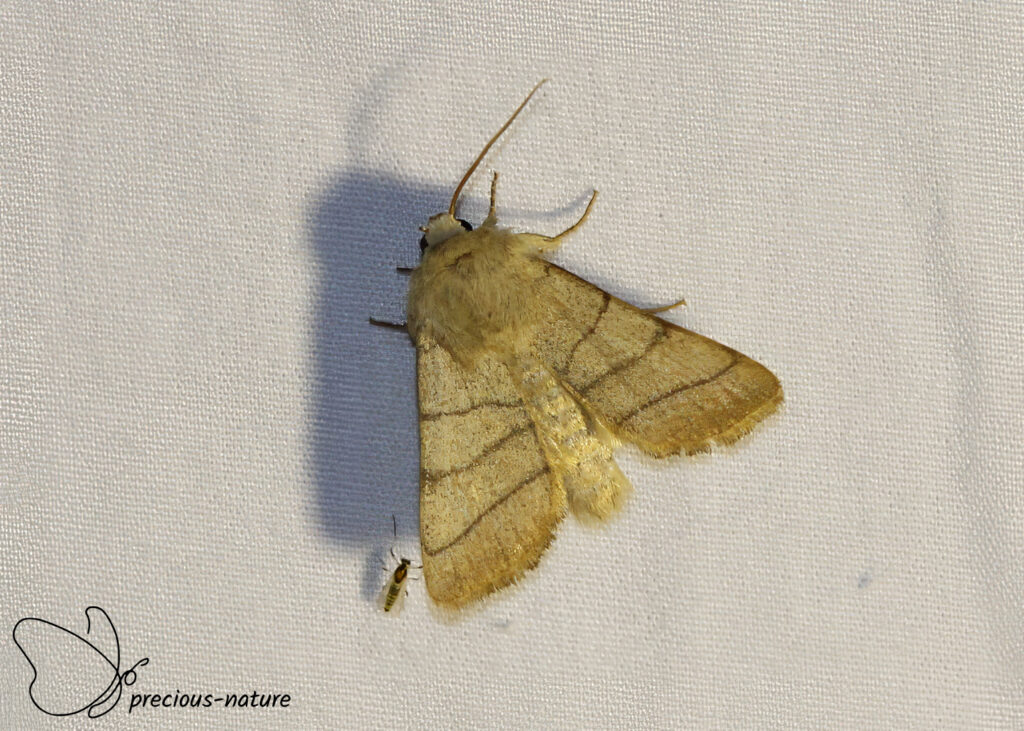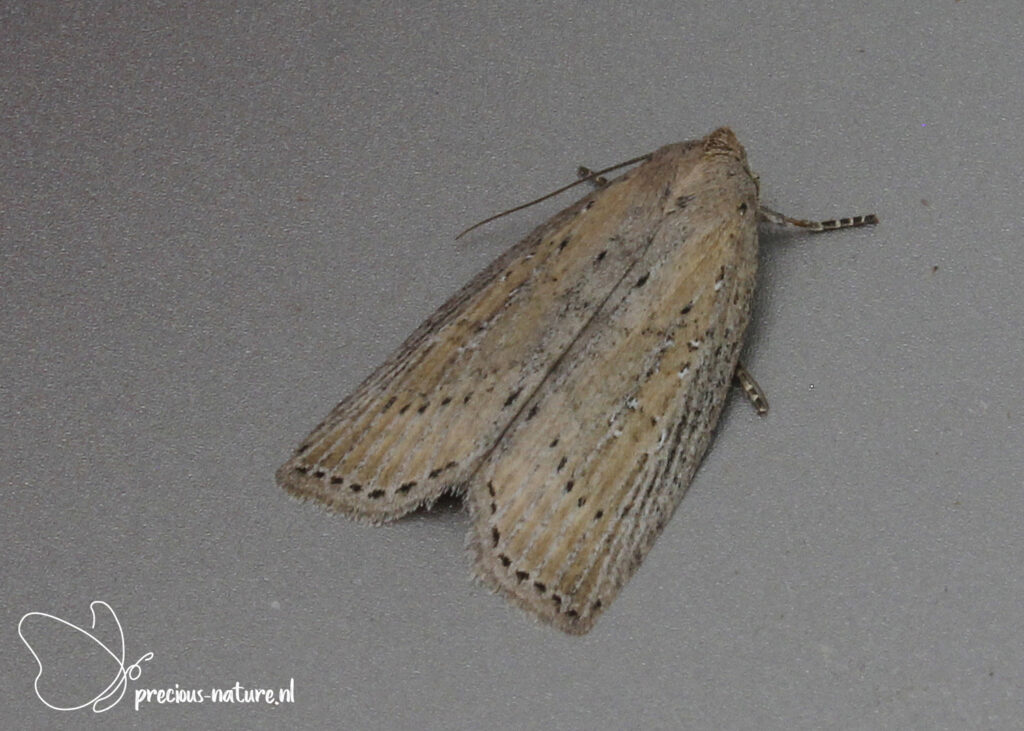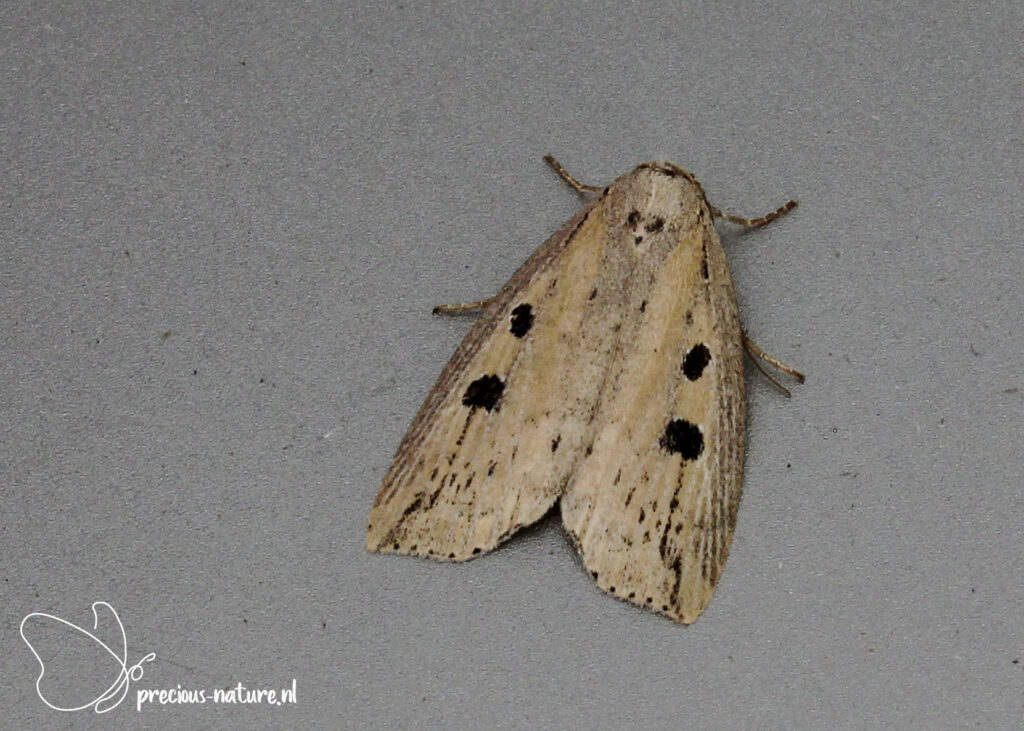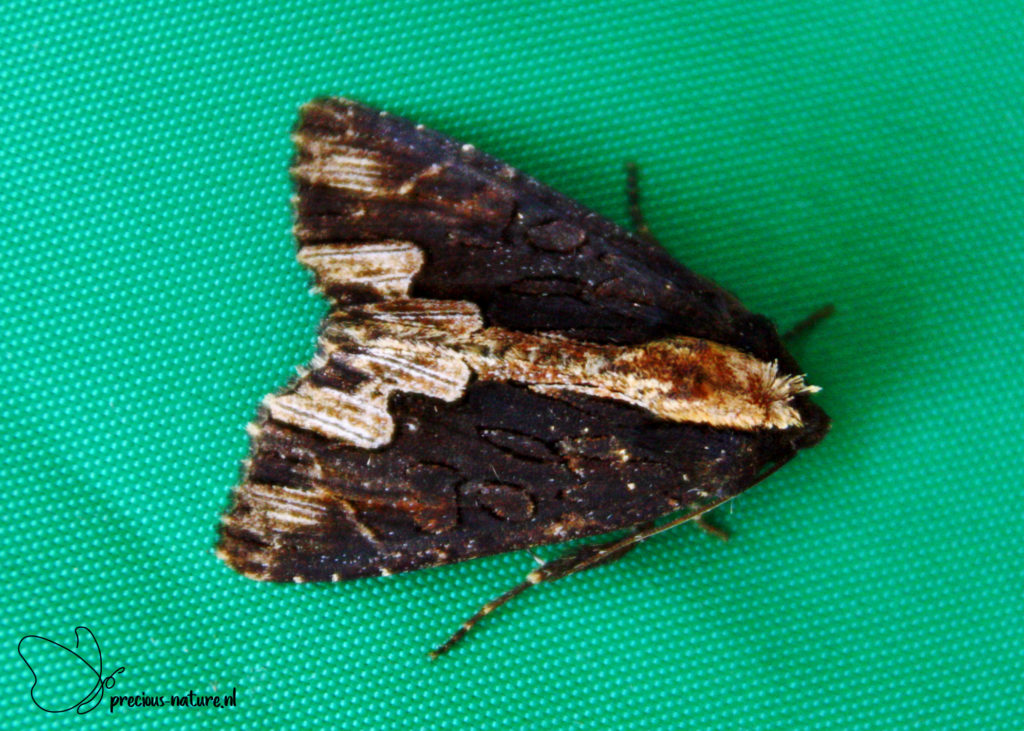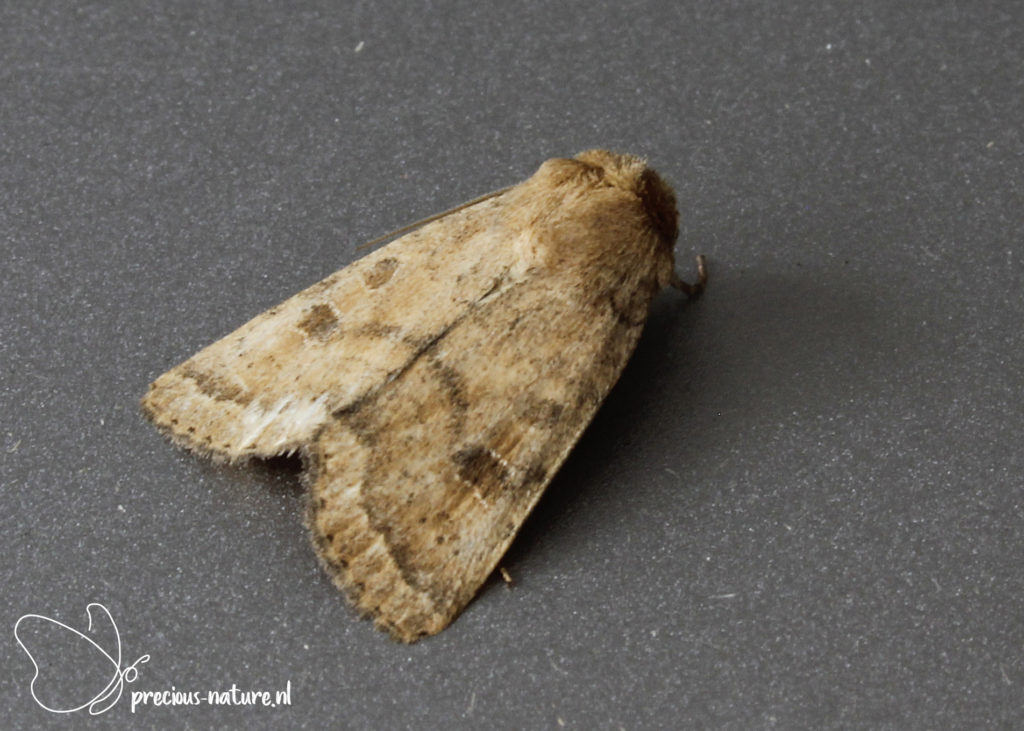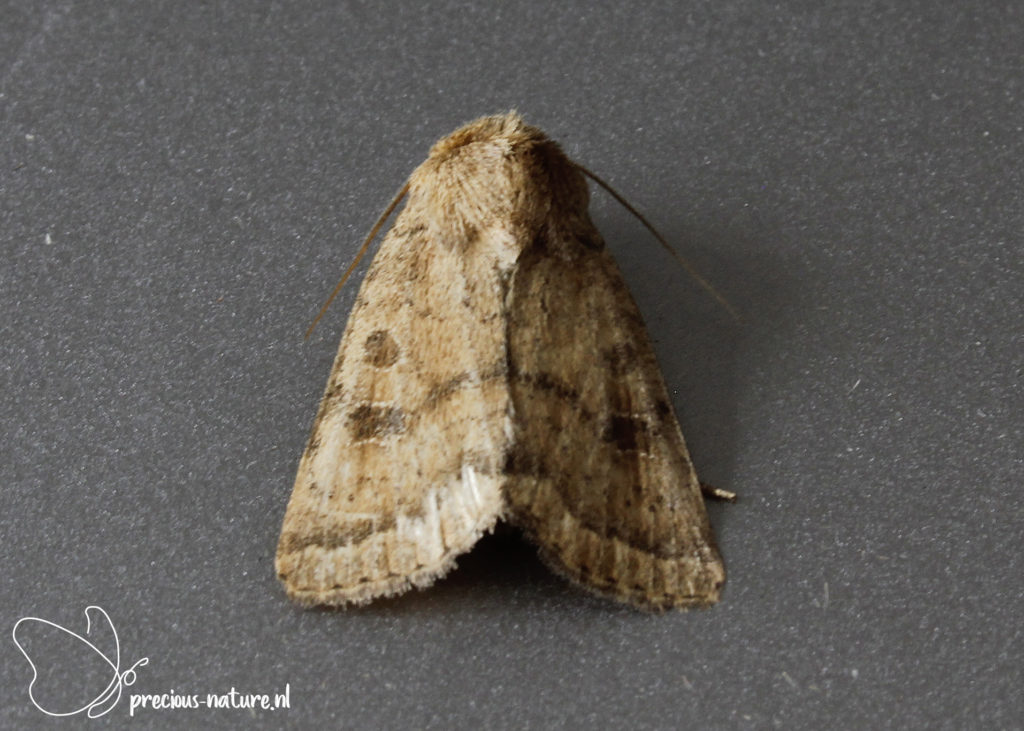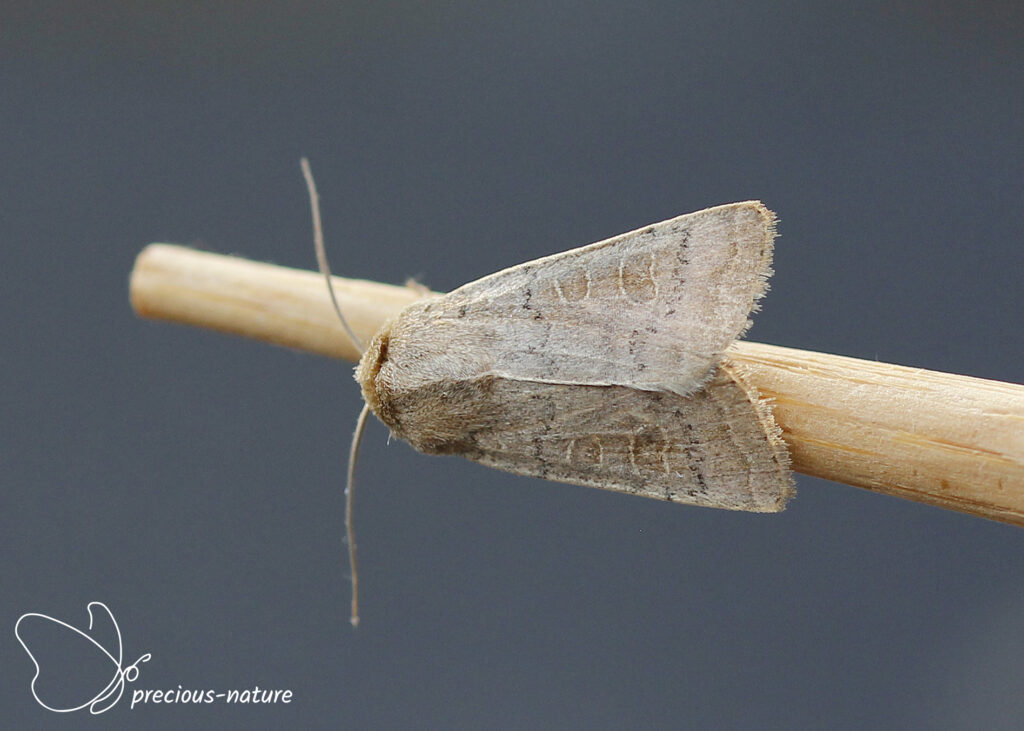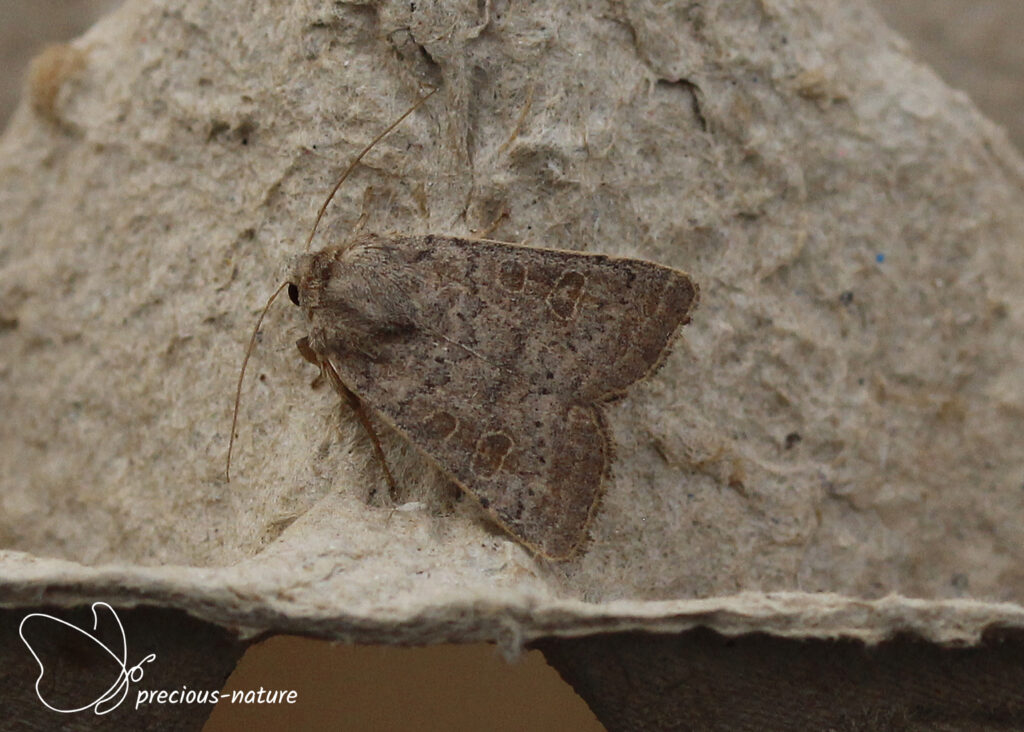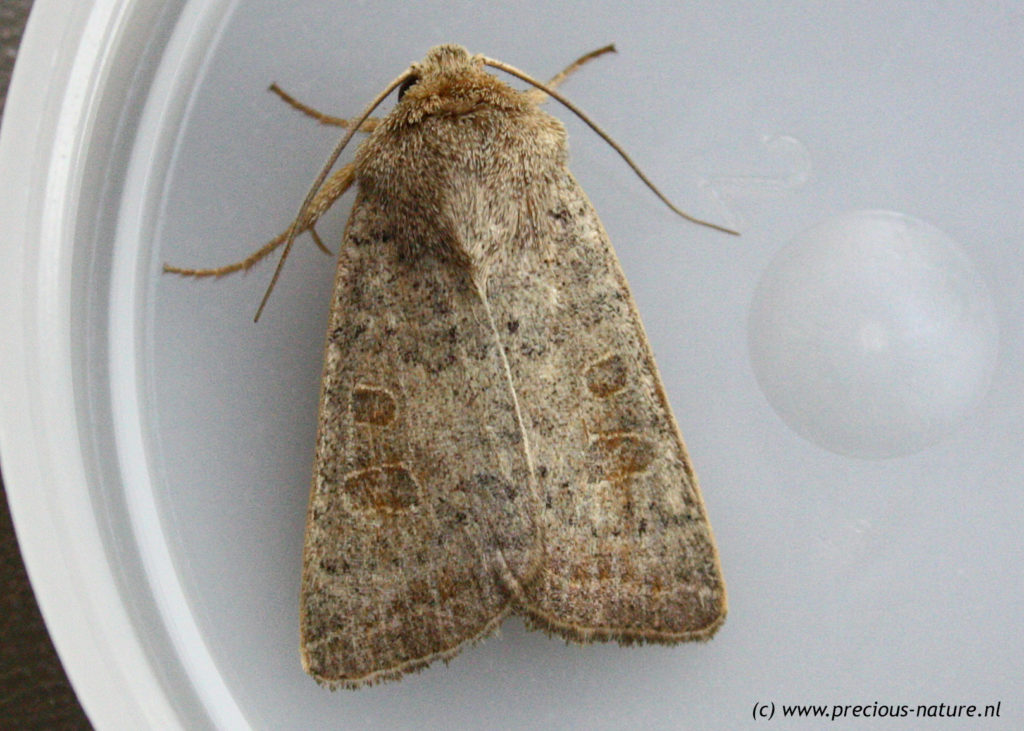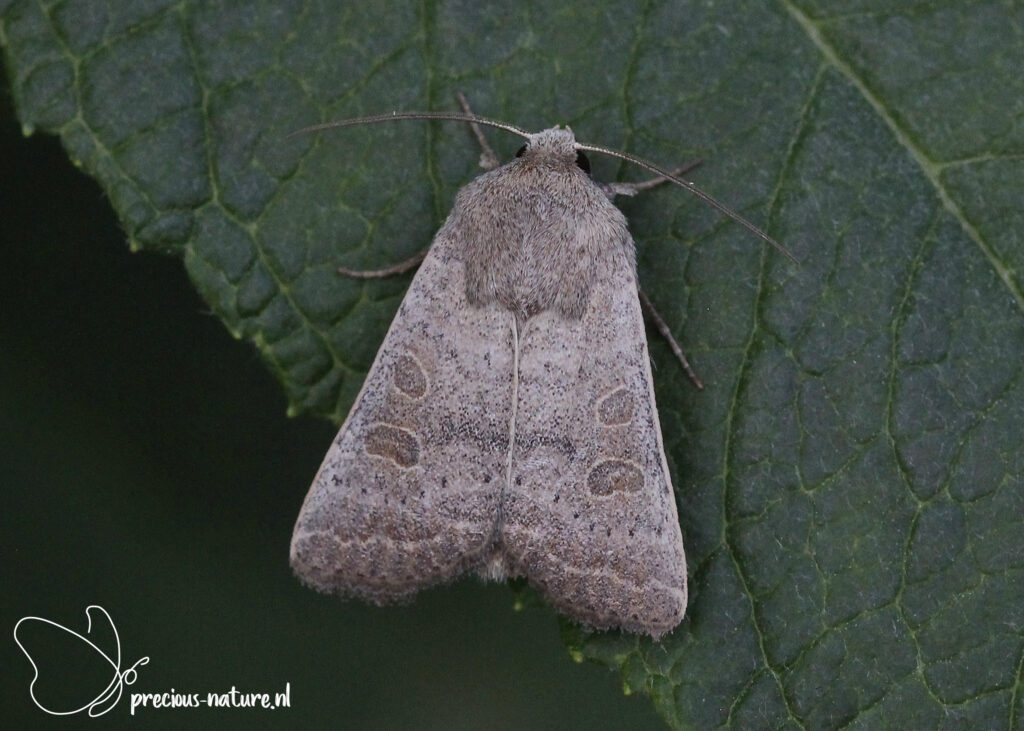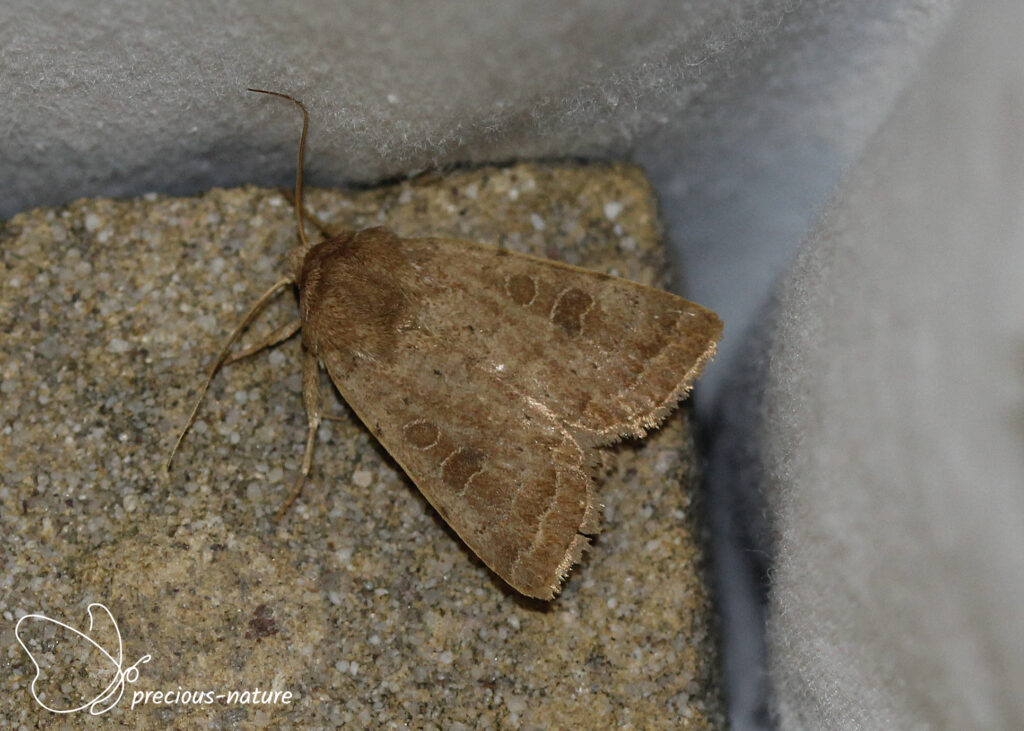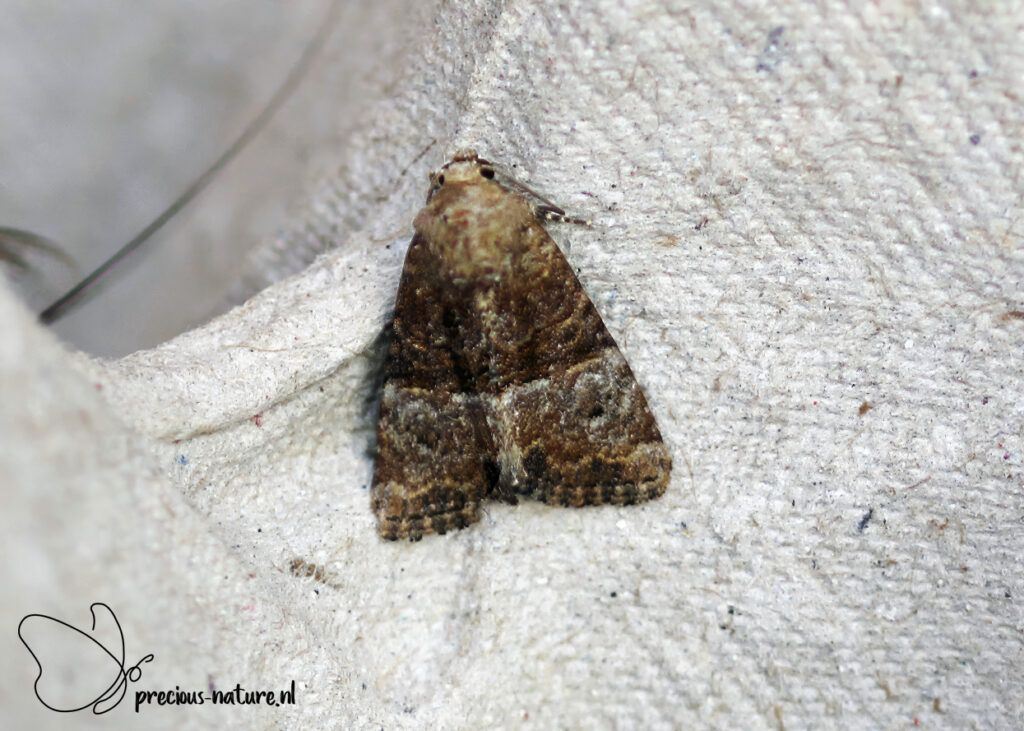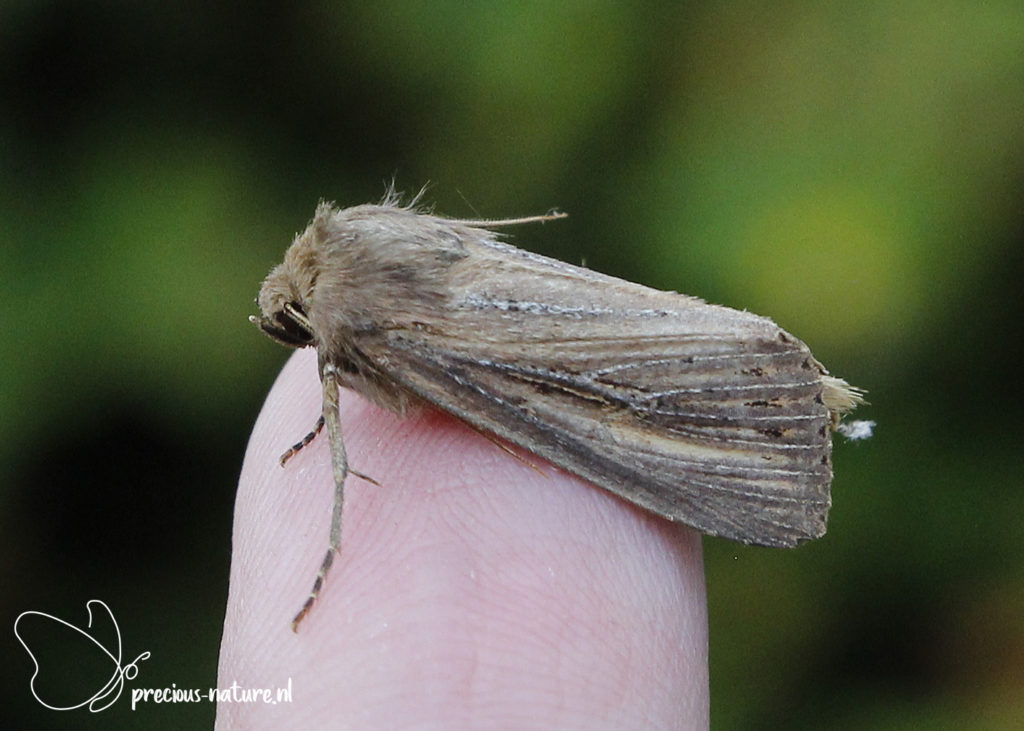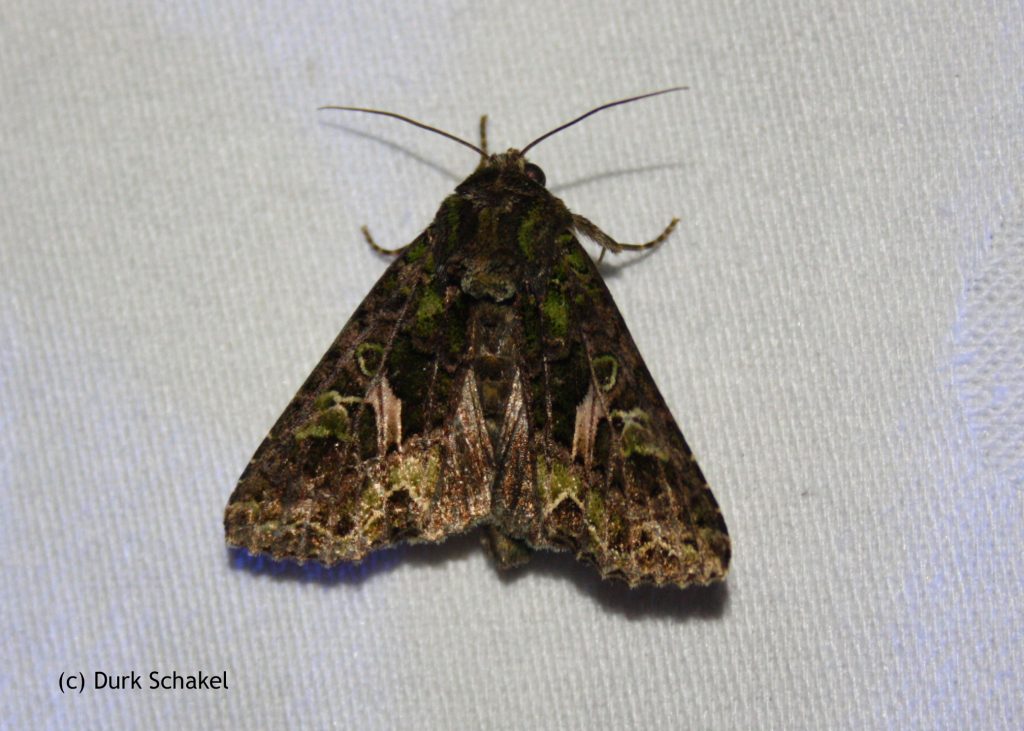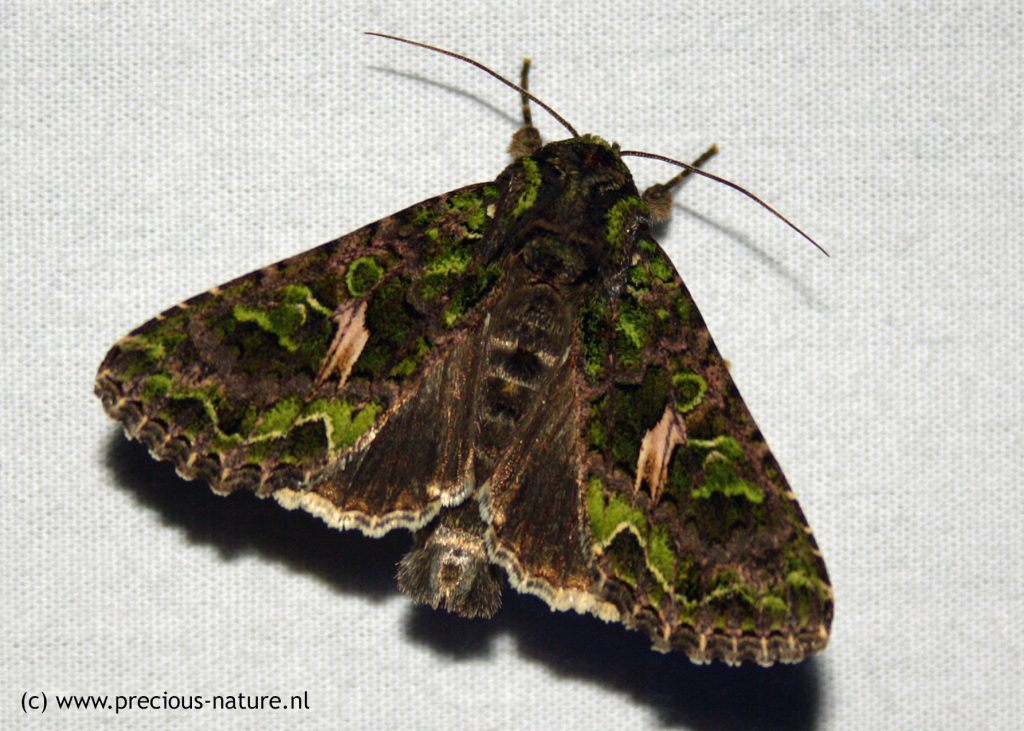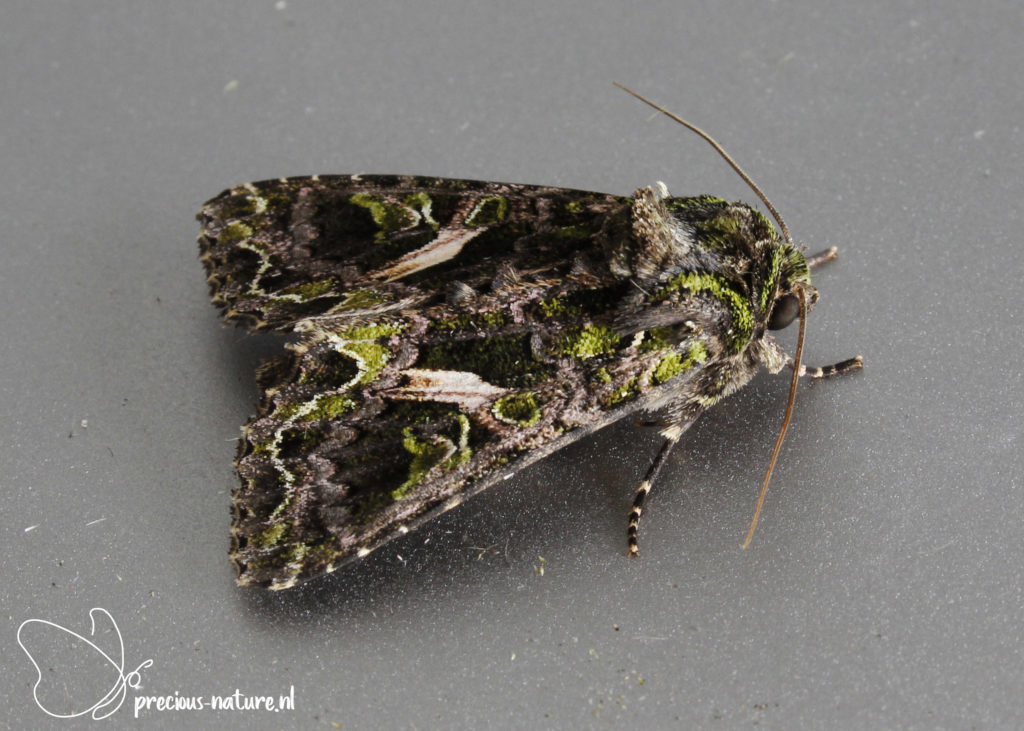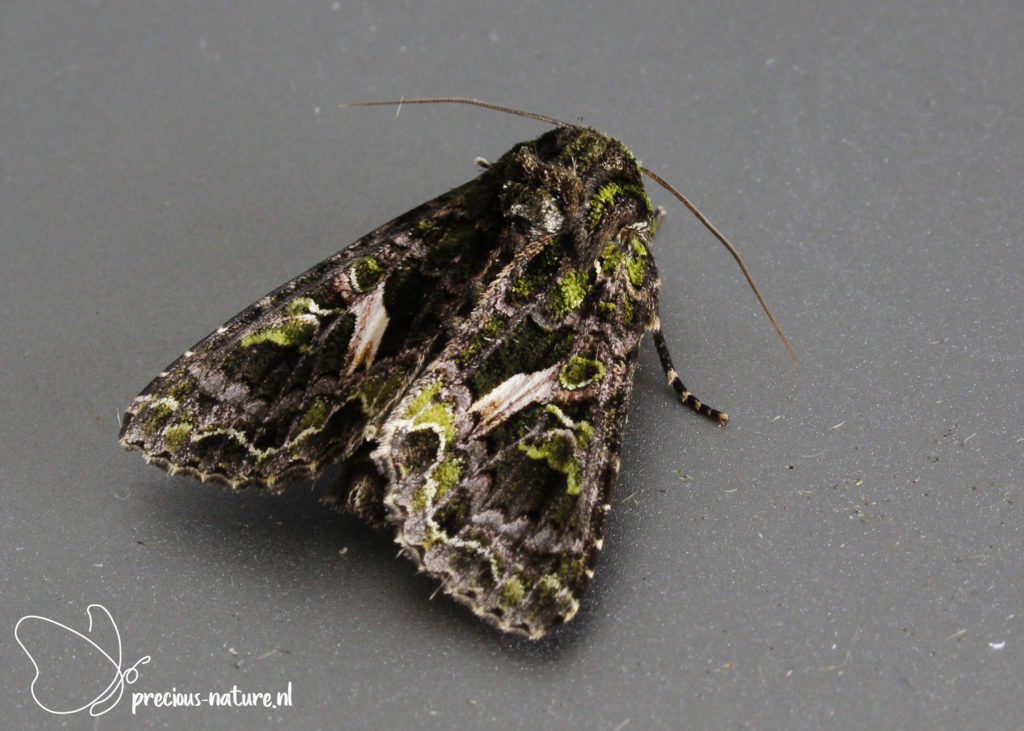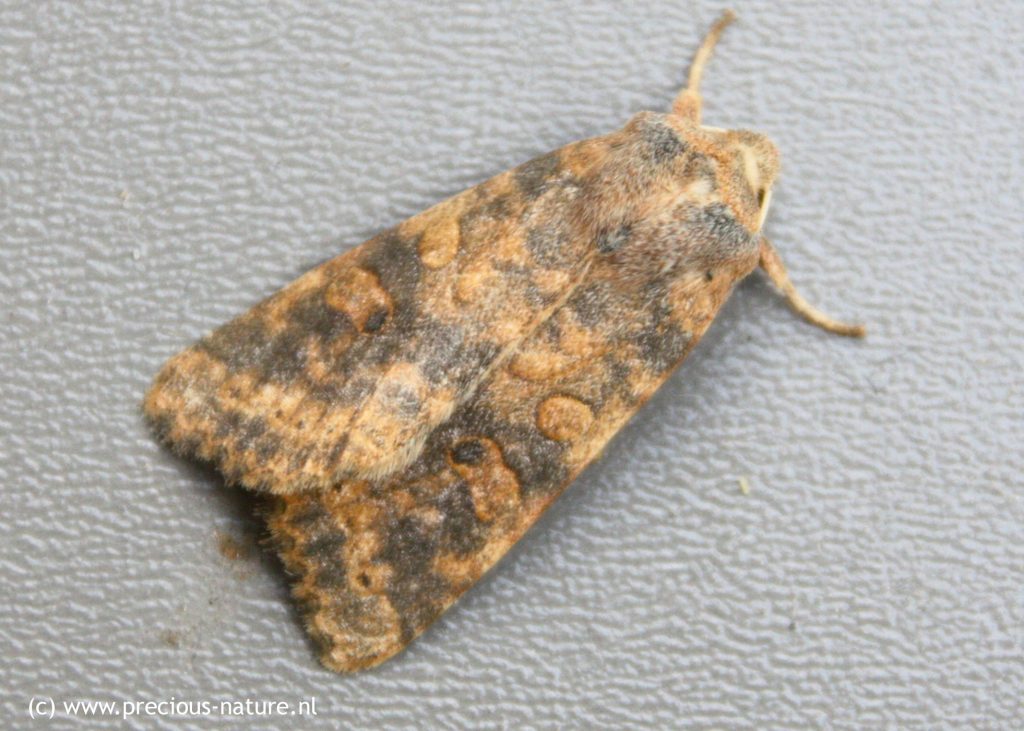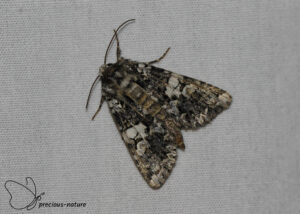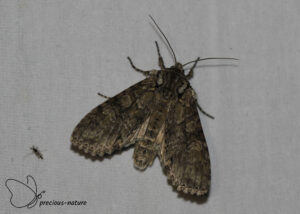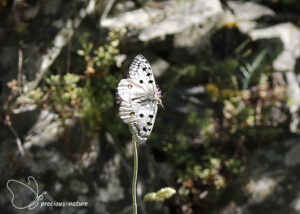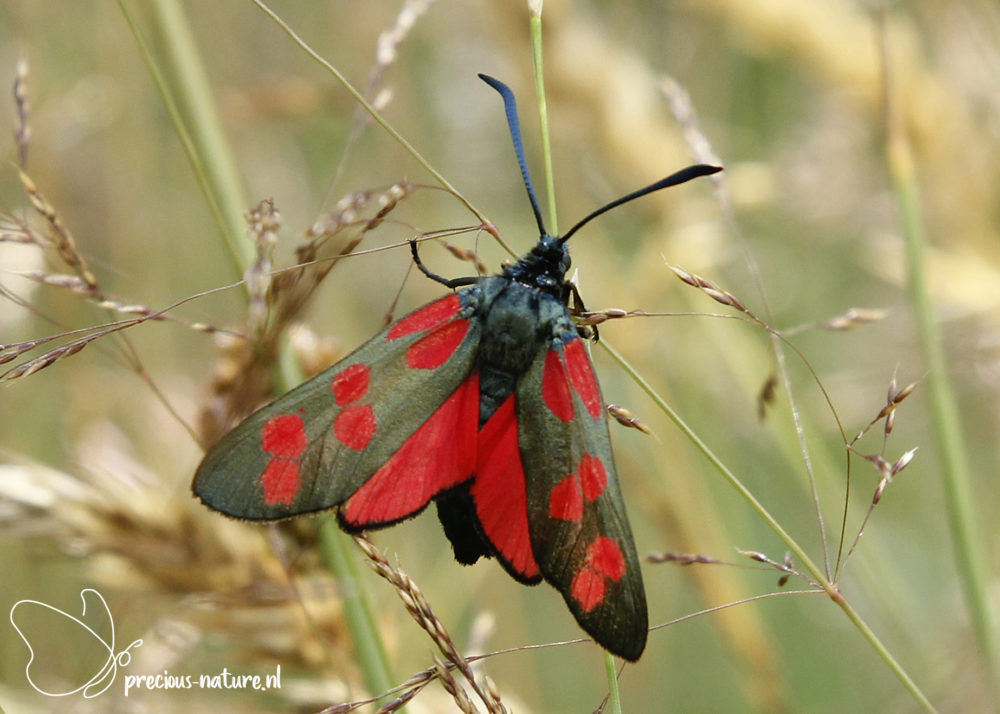Xyleninae is a subfamily of the Owlet Moths (Noctuidae).
Genus: Agrochola
Beaded Chestnut – 2018 (NL)
(NCBI-index: 987871)
A very variable owlet moth in colour but still easily recognisable is the Beaded Chestnut (Agrochola pycnidia). The forewing has a maroon or reddish-brown base colour but can also be yellowish or sometimes darker and greyish. The dark eye mark is small and elongated, and the kidney mark is usually darker and narrower. On the inside of the wave line, a dark brown or blackish short slash or wedge-shaped spot can often be seen along the costa. In the midfield, some weaker black spots are present. Some specimens exhibit a weak pattern, while others feature striking light or dark transverse lines and light-coloured veins. The flight period is from September to mid-November in one generation, and the wingspan is 30-35 mm. Host plant: Various trees and shrubs. Dutch name: Variabele herfstuil. Frisian name: Fariabel hjerstûltsje.
Flying period:

Genus: Agrochola
Lunar Underwing – 2020 (NL)
(NCBI-index: 1.869734)
A characteristic feature of the Lunar Underwing (Agrochola lunosa) is the dark crescent-shaped central spot on the whitish, mottled hindwing. This also distinguishes this owlet moth from the similar Beaded Chestnut (Agrochola lychnidis), which has a brown hindwing where the central spot is missing. The forewing of the Lunar Underwing has a straight costa, which tapers narrowly but has a blunt apex. The ground colour is very variable and varies from very light yellow-brown to very dark brownish-grey. Both the transverse lines and the veins are light in colour and visible. The wavy line consists of a series of black spots and ends close to the costa via a kink in two black arrow spots. The kidney- and oval marks are pretty large, slightly rimmed, and filled with dark. The flying period in one generation is from mid-August to mid-October, and the wingspan is 32-38 mm. Host plant: Various grasses. Dutch name: Maansikkeluil. Frisian name: –
Flying period:

Genus: Arenstola
Fen Wainscot – 2020 (NL)
(NCBI-index: 988067)
The Fen Wainscot (Arenostola phragmitidis) is a moth with no pronounced characteristics. The forewing has a solid grey or reddish-tinged yellow-brown colour without any markings. Closer to the marginal area, the wing becomes darker, and the fringe is dark brown. The hindwing is grey and has a lighter fringe. The wingspan is 32-36 mm, and the flight period is from June to early September for one generation. Host plant: Reed. Dutch name: Egale rietboorder. Frisian name: Egale Reidboarder.
Flying period:

Genus: Atethmia
Centre-barred Sallow – 2021 (NL)
(NCBI-index: 988071)
The Centre-barred Sallow (Atethmia centrago) has a slightly scalloped trailing edge of the broad forewing at a somewhat right angle to the leading edge and deviates firmly inwards from the middle. The forewing is yellow to orange or brown with a dark median band that may contain greyish spots. The inner transverse line is remarkably straight. The kidney mark is part of the median band and can sometimes be seen faintly. The oval mark is not visible. The drawing is pretty consistent, but can vary significantly in intensity. The wingspan is 32-60 mm, and the flight period is one generation from August to mid-October. Host plant: Common ash. Dutch name: Essengouduil. Frisian name: –
Flying period:

Genus: Charanyca
Treble lines – 2019 (NL)
(NCBI-index: 987901)
The solidly built Treble Lines (Charanyca trigrammica) has a broad, slightly tapered forewing. A characteristic is the pattern of three roughly parallel dark transverse lines on a lighter, smooth surface. The ante-median and post-median transverse lines are thin and quite sharp, and the median is more expansive and diffuse. The colour of the wing is a mixture of grey or orange-brown and milky white with fine dark speckling. The costal area is often darker than the rest of the wing. The flight period is from the end of April to the end of July in one generation, and the wingspan is 35-40 mm. Host plant: Plantain, Dandelion. Dutch name: Drielijnuil. Frisian name: Trijelynûltsje.
Flying period:

Genus: Chilodes
Silky Wainscot – 2020 (NL)
(NCBI-index: 987442)
The Silky Wainscot (Chilodes maritima) is a slender owlet moth with a greyish forewing. The forewing has a curved costa that forms an almost right angle with the termen. The colours and markings are variable. Most specimens have delicate grey veins and a fine black speckling. It resembles the Reed Veneer (Chilo phragmitella) and Bulrush Veneer (Calamotropha paludella), but these micro-moths from the grass moth family (Crambidae) have long palps. Some specimens have a striking oval and kidney mark, such as the first specimen I saw of this species. The hindwing is white. The wingspan is 29-36 mm, and the flying period is from June to September for one generation. Host plant: Reeds and living and dead invertebrates. Dutch name: Smalvleugelrietboorder. Frisian name: Smelwjukreidboarder.
Flying period:

Genus: Dypterygia
Bird’s Wing – 2019 (NL)
(NCBI-index: 987927)
A very recognisable and easily identifiable owlet moth is the Bird’s Wing (Dypterygia scabriuscula). The predominantly black wings have a light brown dorsum that tapers towards the inner edge in two arches into a wider brown spot against the costa. The top of the chest piece connects to the termen and is also brown and adorned with a hair-shaped crest. Near the apex is a light brown spot. The owl marks are the same colour as the wing and are surrounded by a dark, thin line. The flight period is from mid-April to August in two generations, and its wingspan is 32-37 mm. Host plant: Dock, Knotgrass. Dutch name: Vogelwiekje. Frisian name: Fûgelwjukje.
Flying period:

Genus: Hoplodrina
The Uncertain – 2017 (NL)
(NCBI-index: 938192)
The Uncertain (Hoplodrina octogenaria) has a brown to yellow-brown forewing at the top. Characteristics include the grey speckling, which makes it look like a layer of dust over the wings or indicates whether the moth has already flown off. This was also the case with the specimen I first spotted. Two dark transverse bands run across the forewing. The inner is coarsely scaly, while the outer has a finer shape. The small oval and kidney marks are darker than the base colour. It flies in one generation from May to August, and the wingspan is 28-34 mm. Host plant: Dock, Plantain. Dutch name: Gewone stofuil. Frisian name: Gewoan stofûltsje.
Flying period:

Genus: Hoplodrina
Vine’s Rustic – 2017 (NL)
(NCBI-index: 875924)
The Vine’s Rustic (Hoplodrina ambigua) is an owlet moth similar to its immediate relatives. The forewing is light brown with grey speckles. The oval and kidney marks are visible with their brown colour and the white border. The costa of the forewing is almost straight and narrower than that of the Uncertain (Hoplodrina octogenaria). Two dotted transverse lines can be seen on the top of the forewing. The flight period is from May to October in two generations, and the wingspan is 32-34 mm. Host plant: Dock, Plantain. Dutch name: Zuidelijke stofuil. Frisian name: –
Flying period:

Genus: Hoplodrina
The Rustic – 2017 (NL)
(NCBI-index: 987956)
The Rustic (Hoplodrina blanda) is difficult to distinguish from some other relatives, particularly the Uncertain (Hoplodrina octogenaria). The post-median wavy transverse line in the Rustic consists more or less of black dots instead of a continuous line. The owl marks are more significant than the Uncertain and are white-rimmed. The flight period is one generation, from June to September, and the wingspan is 31-35 mm. Host plant: A variety of low plants. Dutch name: Egale stofuil. Frisian name: –
Flying period:

Genus: Mesoligia
Cloaked Minor – 2020 (NL)
(NCBI-index: 997551)
Sometimes, you are not looking for butterflies; you walk outside and suddenly see an interesting moth. This was also the case with the Cloaked Minor (Mesoligia furucula). While I walked around the house in the afternoon, I suddenly saw this sand-coloured owlet moth. Despite the many variations in colour and size, the Cloaked Minor is usually easy to recognise. A strikingly straight division between the inner and outer wing halves can be seen. In the most characteristic shape, you can see a contrast-rich dichotomy between the dark brown inner wing half and the whitish, with light brown outer half. The light ring and kidney mark are often clearly present. It can be confused with the Rosy Minor (Litoligia literosa). Still, this minor is more prominent, has no dark marginal area, and the division between the two wing halves is less clear. The wingspan is 20-24 mm, and the flight period runs from June to mid-September for one generation. Host plant: Sheep’s-fescue, Tufted Hair-grass, False Oat-grass. Dutch name: Zandhalmuiltje. Frisian name: –
Flying period:

Genus: Nonagria
Bulrush Wainscot – 2020 (NL)
(NCBI-index: 988137)
A species found throughout the Netherlands is the Bulrush Wainscot (Nonagria typhae). The broad forewing has a costa and termen that almost form a right angle. The apex is slightly sharper in the male than in the female. The forewing is dark brown in the male and more yellowish-brown in the female. The light veins with a black speck on both sides stand out nicely. Therefore, a clear black smear can be seen along the central vein. Along the outer margin, the light veins have a dark border, and in between them are tiny black arrow spots. The black checkered fringe line is visible. In very dark specimens, the three light spots along the costa close to the apex stand out nicely and the series of light spots in the fringes. The flight time in one generation is from the end of June to the end of October, and the wingspan is 45-50 mm. Host plant: Reedmace. Dutch name: Lisdoddeboorder. Frisian name: –
Flying period:

Genus: Trachea
Orache Moth – 2019 (NL)
(NCBI-index: 988165)
The Orache Moth (Trachea atriplicis) is a brownish-grey owlet moth with moss-green spots on the top of the forewing and a white zig-zagging transverse line. The characteristic is the slanting pinkish-white streak in the midfield. The owl marks are partly white-rimmed. The flight time is from May to October in two generations, and its wingspan is 38-42 mm. Host plant: Orache, Goosefoot. Dutch name: Meldevlinder. Frisian name: Mealjeflinter.
Flying period:

Genus: Xanthia
Dusky-lemon Sallow – 2018 (NL)
(NCBI-index: 987433)
A beautiful owlet moth I discovered in the moth trap is the Dusky-lemon Sallow (Xanthia gilvago). This owlet moth has a striking, dull orange-yellow or orange-brown forewing and a dark brown, spotty band pattern. This pattern is sometimes reduced to a few dark spots and unclear transverse lines. The inner lobe of the kidney mark is darkly filled. The hindwing is whitish and sometimes darker at the tornus. The flight period spans one generation, from late August to early November, and the wingspan ranges from 32 to 38 mm. Host plant: Elm and various herbaceous plants. Dutch name: Iepengouduil. Frisian name: –
Flying period:


